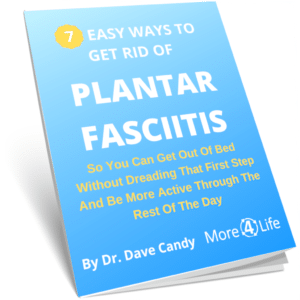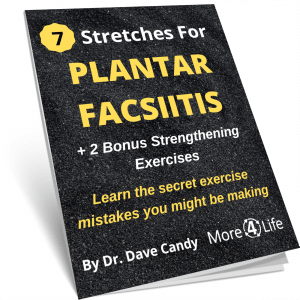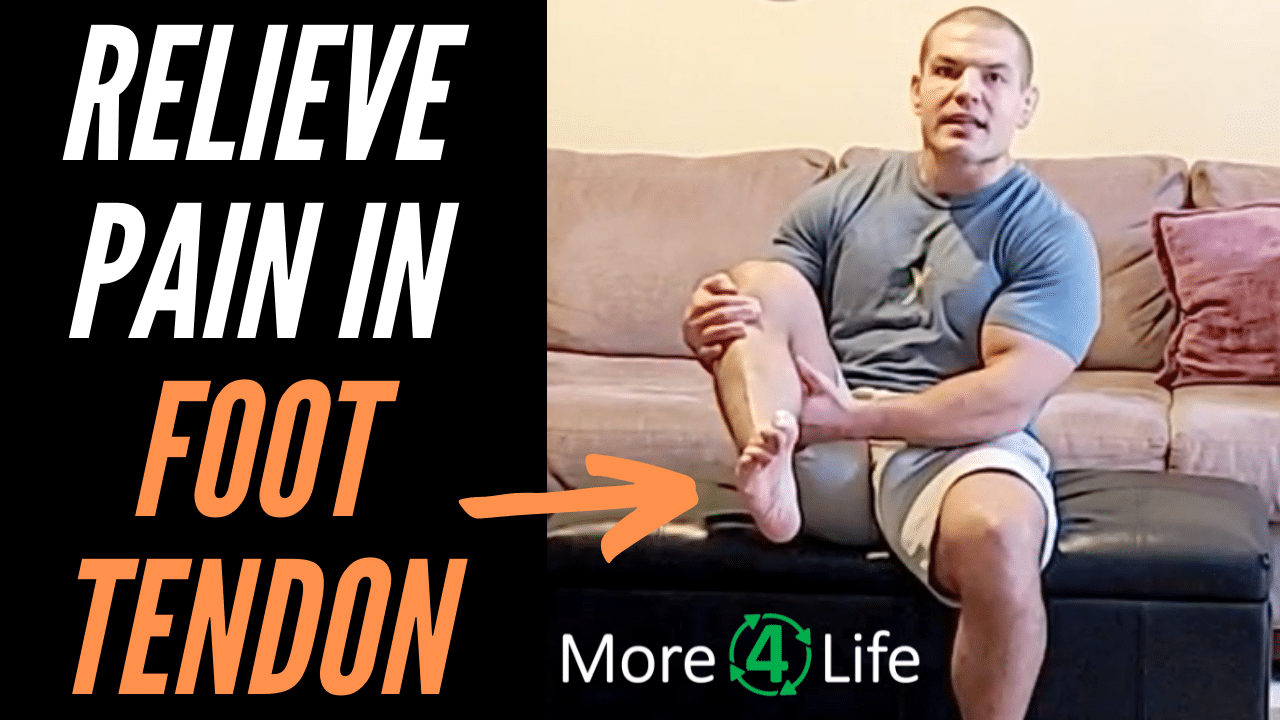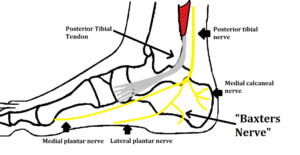Do You Get Tendon Pain In Your Foot?
Foot tendon pain can be annoying at best and disabling at worst, especially if you spend a lot of time on your feet. Watch the video to learn what causes pain in foot tendons how to relieve foot tendon pain.

What Causes Pain In Foot Tendons?
There are many different causes of tendon pain in the foot. To understand what the cause your foot tendon pain, it helps to first define which of the foot tendons is bothering you.
Locations of Foot Tendon Pain
-
Tendon pain on the inside of the foot and ankle
-
Achilles tendon pain (back of heel)
-
Tendon pain on the outside of the foot and ankle
-
Extensor tendon pain (top of foot)
-
Pain in tendon on the bottom of your foot
Pain In Foot Tendon On Inside Of Ankle
The tendons on the inside of your ankle originate from muscles on the inside of your lower leg. Their function is to help control your ankle stability when walking, keep your arch from flattening, and to curl your toes.
Pain in the tendons on the inside of your ankle is often caused overpronating
Pronating means your foot flattening and your lower leg twisting inward in order to absorb shock while walking or running. This is normal, but if you pronate too much, this can cause the tendons on the inner foot and ankle to get overstretched.
Additionally, the tibial nerve that also runs behind the bone on the inside of your ankle can also get overstretched and irritated.
Irritation of the tendons and tibial nerve on the inside of the ankle (called “tarsal tunnel syndrome”), can cause pain on the inside of the ankle as well as pain on the bottom of the foot. In fact, tarsal tunnel syndrome often gets misdiagnosed as plantar fasciitis.
Fortunately, many of the same types of treatments for foot tendon pain also help with tarsal tunnel syndrome
By controlling how much you pronate your foot, wearing foot orthotics if needed, stretching your claves, and strengthening your foot and ankle muscles, you can prevent pain in the tendons on the inside of your foot and ankle.
Want To Learn How?
Download a Free copy of our Plantar Fasciitis Stretching & Strengthening Guide

Pain In Achilles Tendon (Back Of Heel)
Achilles tendon pain often occurs from improper foot and ankle movement over time. It is technically an “overuse” injury, but it’s not so much the amount of usage, but the amount of improper usage.
Think about it: a marathoner can run miles and miles on end repeatedly without Achilles tendon problems, but someone who just started playing pickleball may develop it rather quickly.
Achilles tendon pain can vary from tendonitis or tendinopathy to an Achilles tendon rupture
The milder forms of Achilles tendinitis or tendinopathy can happen in either the middle part of the tendon, or at their attachment to the heel.
What causes Achilles tendonitis?
Most Achilles tendon problems are caused by overstretching or microtears within the Achilles tendon. Most of the time these microtears are present WITHOUT inflammation, meaning that they’re more often tendinopathies (-pathy = “a disorder of”) than tendonitis (-itis = “inflammation of”).
That's why anti-inflammatories or even cortisone injections don't always help Achilles tendon pain. In fact, repeated cortisone injection can make tendons weaker put you at higher risk for a tendon rupture.
The Achilles tendon is strong, but...
The Achilles tendon is extremely strong and resistant to tensile forces that happen such as when landing from a jump or pushing off when walking and running. The Achilles tendon’s strength comes from the fact that it’s a thick tendon with fibers that run parallel to one another. Thus, it’s resistant to forces applied along the direction of those fibers (up-and-down if you’re standing).
However, the Achilles tendon is NOT resistant to shear forces (side-to-side if you’re standing)
As such, overpronating (flattening the foot too much), or oversupinating (not flattening the foot enough), can cause pain in the Achilles tendon and make it more vulnerable to injury.
Can Nerves Cause Achilles Tendon Pain?
If you’ve been reading my blogs for awhile, you’ll know that pain isn’t always caused by what the most obvious structure. In short, tendon pain isn’t always tendon pain.
There’s a small nerve that runs along the outside of the Achilles tendon called the sural nerve. The sural nerve can often cause symptoms similar to Achilles tendon pain.
The sural nerve often gets irritated by excessive supination of the heel, which overstretches the sural nerve. Joint manipulation of the foot and ankle can help, as can orthotics.
Need Help For Achilles Tendon Pain?
What Causes Achilles Tendon Ruptures?
Achilles tendon ruptures are classically described as a “gunshot” type of sound where the Achilles tendon and calf muscle will roll up in the calf like a window shade.
Achilles tendon ruptures may occur acutely with an injury, or as an overuse ("prolonged misuse") problem from letting a tendinopathy go without treatment for too long.
In reality though, almost all Achilles tendon ruptures are to some extent overuse problems.
In acute cases, the “injury” is usually just the straw that broke the camel’s back – or Achilles in this case.
Middle-aged weekend warriors are the group at highest risk for an Achilles tendon rupture, especially if they don’t warm up or stretch properly prior to activity.
Risk factors for Achilles tendon rupture include:
- Age. The 30-40 years old
- Sex. Achilles tendon ruptures are more common in men than women.
- Recreational sports that require sudden starts and stops such as basketball, tennis, or pickleball
- Steroid injections. Corticosteroids such as cortisone weakens tendons. Having too many injections can put you at risk
- Certain antibiotics such as ciprofloxacin (Cipro) or levofloxacin (Levaquin)
- Obesity. Excess weight puts more strain on the tendon.
Want To Prevent Achilles Tendon Rupture?
Talk to our specialist to learn how
Pain In Foot Tendon On Outside Of Ankle
The tendons on the outside of your ankle don’t often get hurt from overuse as do the tendons on the inside or back of your ankle. Usually the tendons on the outside of your foot and ankle get injured from landing on a pointed foot.
This can cause the ligament that holds the tendons In place to tear. Subsequently, you can get popping of the tendons on the outside of your ankle when flexing your foot.
Most of the time, this isn't a serious problem. However, if you've recently sustained an injury and you're having some pain in the tendons on the outside of your ankle, wearing an ankle brace for a short period of time can help.
Make sure to maintain your calf flexibility while wearing the brace
Pain In Foot Top Tendons (Extensor Tendonitis)
Pain in the tendons on top of your foot can be caused from extensor tendonitis.
What Is Extensor Tendonitis?
Extensor Tendonitis is an inflammation of the tendons on top of the foot that lift the toes up. Most often extensor tendonitis is caused by wearing shoes that are too tight, especially if you have high arches.
Although you can’t change your arch height, wearing shoes with a wider width and more vertical room in the toe box can help.
Pain In Tendon On The Bottom Of The Foot
Your plantar fasica is a thick, tendon-like piece of tissue on the bottom of your foot, although it is technically not a tendon per se. However, it covers and protects the muscle in the bottom of the foot while also helping to maintain your arch.
There 4 layers of tiny muscles inside the foot.
When these muscles get irritated, they can mimic symptoms of plantar fasciitis, and these muscles do, of course have tendon. In general, your foot intrinsic muscles help support your arch and flex the toes.
These tendons can get hurt by getting overstretched (overpronating), or from being too stiff in an high arch foot that doesn’t stretch at all.
If you overpronate when walking, balanciing on one foot with your arch lifted can help. Additionally, you may benefit from custom orthotics to control foot pronation.
If you have a high arch foot that underpronates, wearing high-arch, cushioned, shock absorbing orthotics can help.
Need More Help For Pain On The Bottom Of Your Foot?
Click the button below to download a Free copy of our Plantar Fasciitis Guide

How To Relieve Foot Tendon Pain
The question of how to relieve foot tendon pain depends again on which tendon you’re talking about.
In general, here are some tips that help relieve most of types of foot tendon pain:
- Wear shoes with good arch support that aren’t too tight
- Work on your balance. This helps strengthen both your foot muscles, as well as the muscles in your hip that balance your body over top of your foot.
- Make sure you have enough (but not too much) calf flexibility.
- Use the right type of orthotics
- If you have low arches, supportive orthotics can help.
- If you have high arches, cushioned orthotics can help
- If your foot pain is more serious or you've already tried orthotics, you may need a special type of custom orthotic. Click here to learn what type of orthotic are right for you
Special Considerations On How To Relieve Achilles Tendon Pain
As noted above, your Achilles tendon problems often occur from microtears in the Achilles tendon.
What’s one of the common things people try to relieve Achilles tendon pain?
They try to stretch it!
Now, if a tendon is torn and you try to stretch it, what do you think will happen?
It’s probably going to tear even more, potentially putting you at risk for an Achilles tendon rupture.
As mentioned above, the Achilles tendon is strong and resistant to stretching, as long as the stretching is applied parallel to the tendon fibers.
However, if there’s a muscle imbalance between on the inner (medial) and outer (lateral) parts of the calf muscle, this can create forces on the tendon that are NOT parallel to the tendon fibers. These type of shear forces can put the tendon at risk for tearing.
How To Stretch Your Calves For Achilles Tendon Pain
This means that when you have an overstretched or torn Achilles tendon, you also usually have some parts of your calf muscles that are overstretched, and some parts that are under-stretched or stiff.
But how do you stretch the right parts of your calf muscles without further overstretching your Achilles tendon?
Often times it helps to use specific hands-on techniques like manual trigger point therapy or trigger point dry needling to help release the stiff “knotted” areas of your calf muscles, without affecting the overstretched parts of the calves.
GENTLE calf stretching using the proper technique can also help stretch the correct parts of your calf muscles. In many cases, if you’re doing the stretch correctly, you won’t “feel the burn” like you might expect to when stretching. “Feeling the burn” when stretching often means you’re stretching nerves, which you want to avoid.
Heel Raises Can Also Help Achilles Tendon Pain
Yes, this may be painful if your Achilles tendon hurts.
However, heel raises are one of supported by research as an effective treatment for Achilles tendinopathy. You want to make sure that you're keeping your ankle in a neutral position while doing them though.
Learn how to do heel raises for Achilles tendinopathy correctly.




